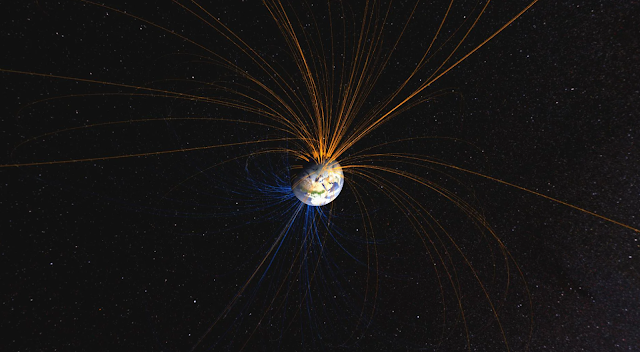Scientists Report a Repetitive Radio Signal Emanating From an Earth-Like Exoplanet
Our Earth’s magnetic field has been vital for sustaining life, protecting its surface from harmful solar radiation and ensuring a stable atmosphere that nurtures our biosphere. Scientists speculate that if extraterrestrial life exists, it may also depend on robust magnetic fields surrounding exoplanets—worlds that orbit other stars.
Previous observations have shown magnetic fields of giant exoplanets like Jupiter interacting with their host stars, in a phenomenon called magnetic star-planet interactions (SPIs). However, detecting magnetism around Earth-sized rocky exoplanets has proven challenging due to their weaker magnetic signals compared to gas giants.
Sebastian Pineda, a research scientist at the University of Colorado, Boulder, and Jacqueline Villadsen, an assistant professor at Bucknell University, have dedicated years to the search for these elusive magnetic field indicators around small planets. Now, the two astronomers present groundbreaking evidence of recurrent radio bursts that might be associated with a magnetic field surrounding YZ Ceti b—an Earth-sized exoplanet situated just 12 light years away from our solar system.
YZ Ceti b completes an orbit in just two days, which means it is way too close to its star to host life, but this ultrashort year also “makes it a uniquely promising case study for magnetic SPIs,” according to a study published on Monday in Nature Astronomy.
“It was super exciting to see the radio data sets show this kind of signature,” Pineda said in an email to Motherboard. “We saw the initial burst detection, and immediately went about coordinating observations for additional monitoring, based on the published planet period, since we were looking for something that happens at the same time in the planet’s orbit.”
“Once we had the additional data, Jackie was looking at it, and was telling me: ‘hey, there are similar radio signals here, right when we were looking and hoping to see them,’” he continued. “It was a bit of feverish excitement: ‘wow, we may really have it here!!’ I’m pretty sure I started pacing around, imagining our next steps: alright, we’ve got work to do to really demonstrate this result, with all the implications etc.”
In their pursuit of these signals, Pineda and Villadsen directed their focus towards short-period small planets, as their proximity to their stars might lead to a more discernible magnetic signature. The swift motion of these planets along their orbits could trigger an interaction between their potential magnetic fields and the star’s own magnetic field, resulting in a pattern of radio bursts that could potentially be observable from Earth.
The researchers believe they might have observed these recurring bursts originating from the YZ Ceti system, but they approach the findings with caution. They acknowledge that it’s not a definitive confirmation. There remains a possibility that these signals are simply a normal part of radio stellar activity commonly seen in stars like YZ Ceti—a slowly rotating red dwarf—without any direct association with planets in the system.
“There are still too many unknowns about the system, but I’d say we are demonstrating the potential of radio data and magnetic star-planet interactions to lead toward measurements of Earth-sized exoplanet magnetic field strengths—I don’t think we’re really there yet,” Pineda said.
“So, we want to continue to monitor the star with the radio observatories, and look for additional recurrence of the radio signals that occur periodically with the same position of the planet in its orbit,” he added. “It can be time consuming and a bit challenging to set up, but that’ll confirm that the radio detections are indeed dependent on the planet, and not something that the star is doing on its own.”
If indeed this discovery marks the first identification of magnetic SPI around an Earth-sized exoplanet, it could significantly aid scientists in their quest to search for habitable planets orbiting other stars. However, there is a catch: seeking magnetic signatures around rocky exoplanets within their stars’ habitable zones, where conditions are conducive to liquid water and potential life, poses a challenge due to the larger orbits of these planets. The increased distance from their stars may offer a potential advantage for any hidden extraterrestrial life, but it also weakens the magnetic interactions between stars and planets, making some of them undetectable.
Nonetheless, the new study provides a potential glimpse into the signals one might expect from a system housing a magnetically shielded planet similar in size to Earth. With time and refinement of techniques, scientists could potentially identify intriguing targets. Pineda suggests that this approach is part of a broader strategy to assess the likelihood of life existing on other worlds.
“First off, fully confirming magnetic field strengths on exoplanets is a requisite for any broader understanding of habitability,” he explained. “It’s not just a temperature question, but the whole star-planet system needs to be thought about holistically, with magnetism as an important ingredient.”
“So, if we know these exoplanets have magnetic fields from the SPI work, we can start to think about questions like what are the properties of those planets, and thus how do the habitable zone planets compare, and what are the chances that they too have similar magnetic fields, even if we can’t measure them yet for the [habitable zone] planets specifically,” Pineda concluded. “If you can infer then that a planet likely has its own field, that’s when you can start thinking about whether individual planets are truly hospitable.”
Do not forget to share your opinion with us to provide you with the best posts !




0 Comments